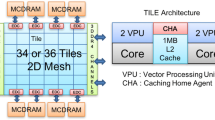Abstract
High performance scientific computers require high bandwidth memory systems. The size of data sets for large scientific codes implies the need for a memory system which contains independent, interleaved banks. We compare the performance of two different control structures for an interleaved memory: bank buffering and address stream lookahead. We show that a centralized lookahead memory controller provides equivalent memory performance to a bank buffering system while simplifying implementation.
Preview
Unable to display preview. Download preview PDF.
Similar content being viewed by others
References
P. Bird and R. Uhlig “Using Lookahead to Reduce Memory Bank Contention for Decoupled Operand References,” Proceedings of the Supercomputing '91 Conference, November 1991, pp. 187–196.
T. C. Chen, Parallelism, Pipelining and Computer Efficiency, Computer Design, January 1971, pp.69–74.
B. Rau, “Pseudo-Randomly Interleaved Memory,” Proceedings of the 18th International Symposium on Computer Architecture, May 1991, pp 74–83.
J. Smith, S. Weiss and N. Pang, “A Simulation Study of Decoupled Architecture Computers”, IEEE Transactions on Computers C-35(8), August 1986, pp 692–702.
Author information
Authors and Affiliations
Editor information
Rights and permissions
Copyright information
© 1992 Springer-Verlag Berlin Heidelberg
About this paper
Cite this paper
Bird, P.L., Topham, N.P., Manoharan, S. (1992). A comparison of two memory models for high performance computers. In: Bougé, L., Cosnard, M., Robert, Y., Trystram, D. (eds) Parallel Processing: CONPAR 92—VAPP V. VAPP CONPAR 1992 1992. Lecture Notes in Computer Science, vol 634. Springer, Berlin, Heidelberg. https://doi.org/10.1007/3-540-55895-0_436
Download citation
DOI: https://doi.org/10.1007/3-540-55895-0_436
Published:
Publisher Name: Springer, Berlin, Heidelberg
Print ISBN: 978-3-540-55895-8
Online ISBN: 978-3-540-47306-0
eBook Packages: Springer Book Archive




